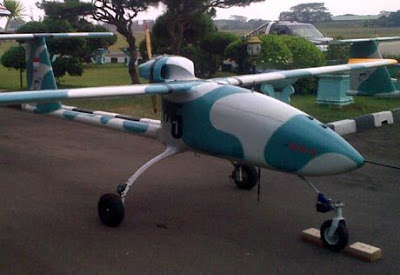
The unmanned aerial vehicle (UAV) features all the characteristics of a surveillance drone, except for its thunderous sound.
“The plane is designed to carry out surveillance. Given its noise levels, however, its targets would easily become aware of its position,” Research and Technology Minister Gusti M. Hatta said during the drone’s flight demonstration, which was also attended by Defense Minister Purnomo Yusgiantoro.
The drone was developed jointly by the Agency for the Assessment and Application of Technology (BPPT) and the research and development division at the Defence Ministry.
Purnomo said after the demo that a squadron of drones would soon join the Indonesian Air Force (TNI-AU), making Indonesia one of a few countries that develop UAVs.
The aircraft, according to the minister, would be placed in the country’s vast border regions.
Indonesia shares land borders with Papua New Guinea to the east, Malaysia and Brunei Darussalam on Borneo, and Timor Leste on Timor Island. Most illegal migrants enter the country along these borders.
As of August this year, some 7,370 migrants had illegally entered Indonesia via Nunukan in East Kalimantan, which directly borders Malaysia.
Aside from surveillance, the UAVs can also be equipped with military applications.
“These UAVs can be upgraded to fire missiles and to carry bombs,” Purnomo said.
Currently, the BPPT and the Defence Ministry’s research and development division have created around 12 UAV prototypes, which bear names including Sriti, Alap-Alap, Gagak, Pelatuk and Wulung.
Wulung, which was tested on Thursday, has a wingspan of about 6 metres, a height of 1.2 metres and a length of around 4 metres. The aircraft performed surprisingly well during the test flight.
Despite the country’s achievement with the UAVs, the BPPT’s engineering researcher, Adrian Zulkifli, admitted that Indonesia was still far behind other countries in terms of unmanned aircraft development.
A report by CNN stated that the US had only 11 drones in 2011 when it declared its War on Terror. However, it currently had around 7,500 drones that have been deployed in many of its military operations overseas, the report said.
The drones can fly as far as Afghanistan, Iran and Pakistan, despite being remotely operated by pilots from military bases in the US.
Meanwhile, their Indonesian counterpart, the Wulung, can currently only fly as far as 73 kilometres from its ground controllers.
“We are working on enabling our UAVs to travel up to 300 kilometres,” Adrian said, adding that the Wulung could fly up to four hours non-stop.
The Wulung and the other UAVs are operated by software originally made by the BPPT.
“We created the software to operate the UAVs,” Adrian said, adding, however, that the aircraft’s engines and cameras were imported from European countries.
“We are learning to produce the engines so that we will not be forever dependent on other nations. However, their quality may not initially be as good as those from countries with advanced experience in UAV production.”
With the planned inclusion of a squadron of UAVs in the Air Force, the Indonesian Army will be one step closer to achieving its minimum essential force in 2025. However, the government still has much to do to meet the goal.-Asia News Network (October 14, 2102)

No comments:
Post a Comment